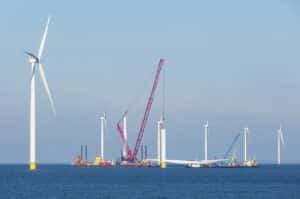
A wind farm under construction off the Dutch coast in 2016. Development of major offshore wind turbine projects south of Martha’s Vineyard should be in high gear by 2023.
Herman Melville poetically wrote in Moby Dick that “In New Bedford, fathers, they say, give whales for dowers to their daughters, and portion off their nieces with a few porpoises a-piece.”
New Bedford’s whaling industry thrived in the 19th century, when whale oil was an important source of energy. But the industry declined after fossil fuels became readily available. Now, in the 21st century, the historic Gateway City of New Bedford and its and deep-water port are positioned to return to the energy sector as the staging area for offshore wind turbine projects.
The term “Gateway City” in Massachusetts is more than just a euphemism applied to municipalities with above-average unemployment and other economic challenges. To qualify as Gateway Cities, municipalities must have 35,000 to 250,000 residents and below-average median household incomes and rates of attaining college degrees. The Massachusetts Department of Housing and Community Development (DHCD) offers attractive financial incentives for development in 26 designated Gateway Cities, including New Bedford.
OZ Adds Double Incentive
The Massachusetts Housing Development Incentive Program (HDIP) is among DHCD’s initiatives promoting these communities. New Bedford used the HDIP to create an “HD zone” in its historic downtown area. This allows New Bedford to exempt 10 percent to 100 percent of the increased value resulting from new construction or substantial rehabilitation in its HD zone, for a five– to 20-year period. Qualifying projects must consist of at least 80 percent housing units available for sale or rent at market prices determined by DHCD. Projects in New Bedford’s HD zone, if certified by DHCD, may also qualify for state income tax credits of up to 25 percent of construction costs, but not land acquisition costs.
Tax incentives for projects in New Bedford’s HD zone are doubly attractive, because it overlaps with an “opportunity zone” established under the federal Tax Cuts and Jobs Act of 2017. Federal tax law encourages investments in opportunity zones for new businesses and construction. These investments can qualify for lucrative federal tax benefits, but relevant tax laws are complicated. Prospective investors in opportunity zones should consult tax professionals.
New Bedford will enjoy improved public transportation when the MBTA extends commuter rail service to New Bedford. Construction is now progressing, with the line scheduled to open in 2023. By that time, development should be in high gear for major offshore wind turbine projects south of Martha’s Vineyard.
Good Prognosis for New Projects
As Massachusetts and other states enact legislation promoting renewable energy and discouraging reliance on fossil fuels, demand for wind turbine energy is predicted to increase.
Last year, Vineyard Wind and Mayflower Wind committed to use the New Bedford Marine Commerce Terminal as the primary staging and deployment base for offshore wind projects. Vineyard Wind’s project is expected to generate 800 megawatts of electricity – enough for 400,000 homes – and to reduce carbon emissions by more than 1.6 million tons per year. Massachusetts regulatory agencies have already issued approvals for Vineyard Wind.
However, the turbine array and transmission cables will be installed in offshore areas under federal jurisdiction, triggering the need for an environmental impact statement under the National Environmental Policy Act. Vineyard Wind hoped that the Department of Interior’s Bureau of Ocean Energy Management (BOEM) would approve its environmental impact statement in 2019, but BOEM balked.
This setback jeopardized Vineyard Wind’s financing, construction schedule and tax credits. But the resulting delay may have worked to Vineyard Wind’s advantage. Wind turbine technology has improved in recent years. Vineyard Wind announced in December that it will upgrade its project to use General Electric’s newly developed Haliade-X wind turbines. These giant turbines will enable Vineyard Wind to produce the same amount of energy with fewer turbines.
Shortly after this announcement, Vineyard Wind withdrew its application to BOEM. Vineyard Wind intends to submit a revised environmental impact statement based on the Haliade-X turbines this year. Project proponents are optimistic that BOEM will be more accommodating to wind turbine projects in 2021 than it was in 2019.

Christopher Vaccaro
Derek Santos, the executive director of the New Bedford Economic Development Council, sees a bright future.
“We have strong political leadership, thoughtful planning in place, and desire to work as hard as it takes to turn what is now more than a decade of foundation building investments into game-changing successes sure to have generational impacts for our citizens,” he said.
New Bedford is prepared for a leadership role in developing offshore wind turbine projects – projects that will reduce dependence on the fossil fuels that ended New Bedford’s whaling industry.
Christopher R. Vaccaro, Esq. is a partner at Dalton & Finegold, L.L.P. in Andover. His email address is cvaccaro@dfllp.com.




 |
| 
